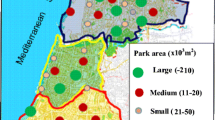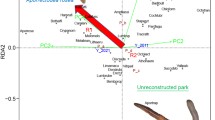Abstract
The effect of visitors’ pressure on the spatial variability of soil properties was investigated in three open green areas in Tel Aviv. Six types of micro-environments were chosen: under oak and pine tree canopy with low (OL and PL) and high (OH and PH) visitors’ pressure; herbaceous area without visitors’ pressure (HE); and resting area under high visitors’ pressure (RA). For each micro-environment soil samples were collected from the upper 0–5 cm depth for organic matter content and moisture determination. Before sampling, soil surface compaction and litter biomass were measured. Soil properties were affected by visitors’ pressure and by the type of micro-environment. Soil organic matter content and soil moisture proved significantly higher under oak trees at low visitors’ pressure. Average litter biomass significantly decreased with increasing visitors’ pressure in the tree micro-environments. Average penetration depth decreased significantly with increased visitors’ pressure in all micro-environments. In all the cases where averages significantly decreased, variance significantly decreased too, but the coefficient of variations increased. This means that variances changed slower than averages. Changes in averages were accompanied by a change of data population structure, which indicated more soil spatial homogeneity under high visitors’ pressure. The data from different intervals of data population of soil properties demonstrated the different sensitivity to visitors’ pressure.
Similar content being viewed by others
References
Aey, W. (1990). Historical approaches to urban ecology. Method and first result from a case study (Lubeck, West Germany). In H. Sukopp, I. Kowarik, & S. Hejny (Eds.), Urban Ecology (pp. 113–129). Den Haag: SPB Academic.
Alexandrovskaya, E. I., & Alexandrovskiy, A. L. (2000). History of the cultural layer in Moscow and accumulation of anthropogenic substances in it. Catena, 41, 249–259.
Ammoti, N. M., Zalva, P., Sanchez, L. F., & Peineman, N. (2000). The impact of single trees on properties of loess-derived grassland and soils in Argentina. Ecology, 81(12), 3283–3290.
Andres-Abellan, M., Del Alamo, J. B., Landete-Castillejos, T., Lopez-Serrano F. R., Garcia-Morote, F. A. & Del Cerro-Barja, A. (2005). Impact of visitors on soil and vegetation of the recreational area “Nachimiento Del Rio Mundo” (Castilla-La Mancha, Spain). Environmental Monitoring and Assessment, 101, 55–67.
Belsky, A. J., Amundson, J. M., Duxbury, S. J., Riha, A. R., Ali, A. R., & Mwonga, S. M. (1989). The effects of trees on their physical, chemical and biological environments in semi-arid savanna in Kenya. Journal of Applied Ecology, 26, 1005–1024.
Beyer, L., Blume, H. P., Elsner, D. H., & Willnow, A. (1995). Soil organic matter composition and microbial activity in urban soils. Science of the Total Environment, 169, 267–278.
Blagoveschensky, U. N., & Samsonova, V. P. (1999). Fractal and the statistical analysis of spatial distributions of Fe–Mn concretions in soddy–podsolic soils. Geoderma, 88, 265–282.
Blume, H. P. (1989). Characteristics of urban soils. MAB workshop “International scientific workshop on soils and soil zoology in urban ecosystems as a basis for management and use of green/open spaces” in Berlin, September 15–19, 1986. Publication of German National Committee of UNESCO program “Man and Biosphere”, Berlin, 30, 23–46.
Bochet, E., Rubio, J. L., & Poesen, J. (1999). Modified topsoil islands within patchy Mediterranean vegetation in SE Spain. Catena, 38, 23–44.
Bruelheide, H., & Udelhoven, P. (2005). Correspondence of the fine-scale spatial variation in soil chemistry and the herb layer vegetation in beech forest. Forest Ecology and Management, 210, 205–223.
Chevallier, T., Voltz, M., Blanchart, E., Chotte, J. L., Eschehbrenner, V., Mahieu, M., et al. (1994). Spatial and temporal changes of soil C after establishment of a pasture on a long-term cultivated vertisol (Martinique). Geoderma, 94, 43–58.
Chung, C. K., Chong, S. K., & Varsa, E. C. (1995). Sampling strategies for fertility on a Stoy silt loam soil. Communications in Soil Science and Plant Analysis, 26(5–6), 741–763.
Dotzenko, A. D., Papamichos, N. T., & Romine, D. S. (1967). Effect of recreational use on soil moisture conditions in Rocky Mountain National Park. Journal of Soil and Water Conservation, 22, 196–197.
Duncan, D. B. (1955). Multiple range and multiple F-test. Biometric, 11, 1–42.
Effland, W. R., & Pouyat, R. V. (1997). The genesis, classification, and mapping of soil in urban areas. Urban Ecosystems, 1, 217–228.
Gersper, P. L., & Holowaychuk, N. (1971). Some effects of stem flow from forest canopy trees on chemical properties of soils. Ecology, 52(4), 691–702.
Gomes-Limon, F. J., & de Lucio, J. V. (1995). Recreational activities and loss of diversity in grassland in Alta Manzanares Natural Park, Spain. Biological Conservation, 74, 99–105.
Gorres, J. H., Dichiaro, M. J., Lyons, J. B., & Amador, J. A. (1997). Spatial and temporal patterns of soil biological activity in a forest and an old field. Soil Biology and Biochemistry, 30(2), 219–230.
Graham, R. C., Ervin, J. O., & Wood, H. B. (1995). Aggregate stability under oak and pine after fore decades of soil development. Soil Science Society of America Journal, 59, 1740–1744.
Jim, C. Y. (1987). Trampling impacts of recreationists on picnic sites in a Hong Kong country park. Environment Conservation, 14(2), 117–127.
Jim, C. Y. (1993). Soil compaction as a constraint to tree growth in tropical and subtropical urban habitats. Environmental Conservation, 20(1), 35–49.
Jim, C. Y. (1998a). Soil characteristics and management in urban park in Hong Kong. Environment and Management, 22(5), 683–695.
Jim, C. Y. (1998b). Urban soil characteristics and limitations for landscape planting in Hong Kong. Landscape and Urban Planning, 40, 235–249.
Karpachevsky, L. O., Voronin, A. D., Demitriev, A. D., Stroganova, M. N., & Shoba, S. A. (1980). Soil and boiogeocenological research in forest ecosystems. Moscow: Moscow State University (in Russian).
Kuss, F. R. (1986). A review of major factors influencing plant responses to recreation impacts. Environment and Management, 10(5), 637–650.
Kutiel, P., & Zhevelev, H. (2001). Recreational use impact on soil and vegetation at picnic sites in Aleppo pine forest on Mt. Carmel. Israel Journal of Plant Sciences, 49, 49–56.
Kutiel, P., Zhevelev, H., & Lavee, H. (2000). Coastal dune ecosystems: management for conservation objective: III. Soil response to three vegetation types to recreational use. Journal of Mediterranean Ecology, 1, 171–179.
Lavee, H., & Poesen, J. W. A. (1991). Overland flow generation and continuity on stone-covered soil surfaces. Hydrological Processes, 5, 345–360.
Lavee, H., Imeson, A. C., & Sarah, P. (1998). The impact of climate change on geomorphology and desertification along a Mediterranean–arid transect. Land Degradation and Development, 9, 407–422.
Liddle, M. J. (1997). Recreation ecology. London: Chapman and Hall.
Liddle, M. J., & Greig-Smith, P. (1975). A survey of tracks and paths in a sand dune ecosystem, I. Soils. Journal of Applied Ecology, 12(3), 893–908.
Lorenz, K., & Kandeler, E. (2005). Biochemical characterization of urban soil profiles from Stuttgard, Germany. Soil Biology and Biochemistry, 37, 1373–1385.
Mapa, R. B., & Kumaragamage, D. (1996). Variability of soil properties in tropical Alfisol used for shifting cultivation. Soil Technology, 9, 187–197.
Marion, J. L., & Cole, D. N. (1996). Spatial and temporal variation in soil and vegetation impacts on campsites. Ecological Applications, 6(2), 520–530.
Marfenina, O. E., Zheveleva, E. M., Zarifova, Z. A., Rozina, M. S., Macarova, N. A., & Ofizerova, O. V. (1984). Effect of normalized recreation on properties of brown forest soils. Vestnik Moskovskogo Universiteta Seriâ Počvovedenie, 17(3), 52–58 (in Russian).
Mc Donell, M. J., & Pickett, S. T. A. (1990). Ecosystem structure and function along urban–rural gradients: an unexploited opportunity for ecology. Ecology, 71(4), 1232–1237.
Meshalkina, J. L., Stein, A., & Dmitriev, Ye. A. (1995). Spatial variability of penetration data on Russian plots in different land use. Soil Technology, 8, 43–59.
Mesheryakov, P. V., Prokopovich, E. V., & Korkina, I. N. (2005). Transformation of ecological conditions of soil and humus substance formation in the urban environment. Russian Journal of Ecology, 36(1), 8–15.
Mosteller, F., & Tukey, J. W. (1977). Data analysis and regression. (A second course in statistics). Leuven: Addison–Wesley Publishing, Co. Inc. A Wiley–Sayce Co-Publication.
Perez, F. L. (1995). Plant-indused spatial patterns of surface soil properties near Andean rosettes. Geoderma, 68, 101–121.
Pouyat, R., Groffman, P., Yesilonis, I., & Hernandez, L. (2002). Soil carbon pools and fluxes in urban ecosystems. Environmental Pollution, 116, S107–S118.
Prasolova, N. V., Xu, Z. H., Saffigna, P. G., & Dieters, M. J. (2000). Spatial–temporal variability of soil moisture, nitrogen availability indices and other chemical properties in hoop pine (Araucaria cunninghamii) plantations of subtropical Australia. Forest Ecology and Management, 136, 1–10.
Rowell, D. L. (1994). Soil science: Methods and application. New York: Longman.
Sanchez, G., & Puigdefabrigas, J. (1994). Interaction of plant growth and sediment movement on slopes in a semi-arid environment. Geomorphology, 9, 243–260.
Sarah, P. (2002). Spatial pattern of soil moisture as affected by shrubs, in different climatic conditions. Environmental Monitoring and Assessment, 73(3), 237–251.
Sarah, P. (2004). Sodium and potassium adsorption ratio along a Mediterranean–arid transect. Journal of Arid Environments, 59, 731–741.
Scharenbroch, B. C., Lloyd, J. E., & Johnson-Maynard, J. L. (2005). Distinguishing urban soils with physical, chemical and biological properties. Pedobiologia, 49(4), 283–296.
Schleus, U., Qinglan, W., & Blume, H. P. (1998). Variability of soils in urban and periurban areas in Nothern Germany. Catena, 33, 255–270.
Smit, A. (1999). The impact of grazing on spatial variability of humus profile properties in a grass-encroached Scots pine ecosystem. Catena, 36, 85–98.
Starr, J. L., Parkin, T. B., & Meisinger, J. J. (1995). Influence of sample size on chemical and physical soil measurements. Soil Science Society of America Journal, 59, 713–719.
Sukopp, H. (2004). Human-caused impact on preserved vegetation. Landscape and Urban Planning, 68, 347–355.
Sukopp, H., Blume, H. P., & Kunick, W. (1979). The soil, flora and vegetation of Berlin’s waste lands. In I. C. Laurie (Ed.), Nature in Cities (pp. 115–131). New York: Chichester.
Sun, D., & Lddle, M. J. (1993). A survey of trampling effects on vegetation and soil in eight tropical and subtropical sites. Environment and Management, 17(4), 497–510.
Zhevelev, H. M., & Kim, E. L. (1984). The influence of recreational pressure on soil compaction. Biologicčeskie Nauki (Moskva), 10, 105–108 (in Russian).
Zhevelev, H., & Sarah, P. (2002). Characterization of soil organic matter content of two sample size populations along a climatic transect. Environmental Monitoring and Assessment, 80, 107–123.
Zheveleva, E. M., Ignatjeva, M. E. & Kavtaradze, D. N. (1989). Soil and the problem of urban plant community formation in the “Ecopolis” (Tow Poushchino, Moscow Region). MAB workshop “International scientific workshop on soils and soil zoology in urban ecosystems as a basis for management and use of green/open spaces” in Berlin, September 15–19, 1986. Publication of German National Committee of UNESCO program “Man and Biosphere”, Berlin, 30, 47–57.
Zinke, P. J. (1962). The pattern of influence of individual forest trees on soil properties. Ecology, 42(1), 130–133.
Author information
Authors and Affiliations
Corresponding author
Rights and permissions
About this article
Cite this article
Zhevelev, H., Sarah, P. The effect of visitors’ pressure on the spatial variability of sandy soil in an urban parks in Tel Aviv. Environ Monit Assess 142, 35–46 (2008). https://doi.org/10.1007/s10661-007-9906-9
Received:
Accepted:
Published:
Issue Date:
DOI: https://doi.org/10.1007/s10661-007-9906-9




